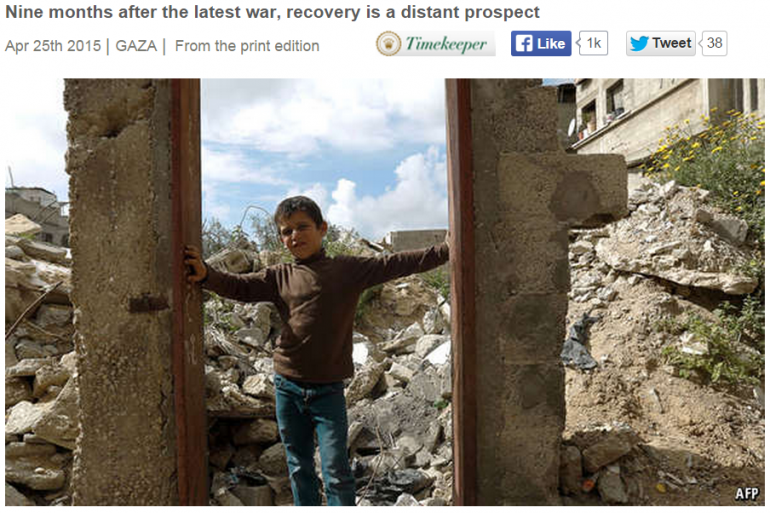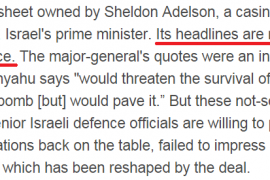An article published in the print edition of The Economist (As Bleak as Ever, April 25th) focused on Gaza reconstruction in the aftermath of the summer war.

The (annonymous) article assigned primary blame to Israel for the slow pace of rebuilding.
NOT one of the 19,000 homes in Gaza destroyed during last summer’s war with Israel has been rebuilt. Six months after would-be donors pledged to raise $3.5 billion, the situation is bleak. Barely a quarter of the promised cash has arrived (see chart). Around 100,000 of Gaza’s 1.8m people remain homeless after families spent a rainy winter in tents, trailers and amid the rubble.
The main reason is that Israel’s government lets Gazans import only a fraction of the cement they need, arguing that it can be used for military purposes—and for building tunnels. So what little Gazans get is on the black market. “It’s like cement is a radioactive material,” says Naji Yusuf Sarhan, Gaza’s deputy minister of housing.
The UN is supervising the flow of material. Just one tightly controlled crossing from Israel into Gaza allows commercial goods. Only a tenth of the 5m tonnes of materials required has so far been let in, says the UN. At this rate, it would take 20 years to rebuild the territory, says Mr Sarhan. To buy on the black market you need a lot of cash. Most Gazans are poor. Half have no job.
First, The Economist is right to observe that only a fraction of the promised cash from donors (Qatar, Saudi Arabia, EU, US, etc.) for reconstruction has arrived. They are also correct to note that “the UN is supervising the flow of material”.
However, The Economist fails to note another important factor, intra-Palestinian violence and intimidation, a factor in the slow pace of reconstruction which even the UN and the Arab League have acknowledged. Secretary general of the Arab League, Nabil Elaraby, told the London-based Al-Hayat newspaper that “the internal differences and the absence of cooperation between the PA and Hamas are behind the delay in reconstructing the Gaza Strip.”
Finally, in addition to their error of omission regarding the role played by Palestinian infighting, their claim that Israel is “the main reason” for the slow pace of rebuilding – due to restrictions on the import of cement – is not accurate.
Indeed, as the article at least hinted at in the third paragraph, per the Gaza Reconstruction Mechanism, the UN is the organization in charge of estimating the damages and determining the quantities of building materials (such as cement) required for each home owner in Gaza whose house was damaged. This data is fed into a system designed by the UN. Homeowners update the Palestinian Authority (PA) about the needed construction materials. The PA (in cooperation with the UN) is in charge of ensuring that those materials reach their destination and are not used for terrorist purposes. (So far, according to the UN, nearly 100,000 Palestinian beneficiaries have participated in the Gaza Reconstruction Mechanism, and over 81,000 tons of cement has been purchased for civilian building projects.)
As Daniel Taub, ambassador of Israel to the UK, noted recently, “reconstruction is not being constrained by any lack of supply, and…stocks of all key materials, including cement, aggregate, and re-bar (steel), remain in surplus”.
The Economist’s claim that “Israel’s government lets Gazans import only a fraction of the cement they need” is not accurate, as there are no limits whatsoever on the quantity of cement allowed into Gaza for (UN and PA approved) civilian reconstruction.




